Observations and Preliminary Vulnerability Assessment of a Hybrid Dune-Based Living Shoreline
Abstract
1. Introduction
2. Methods
2.1. Site Description
2.2. Dune Description
2.3. Beach Topography Observations
2.4. Vulnerability Assessment: Maximum Water Level and Wave Runup Estimates
3. Results
3.1. Substrate Placement Observations and Volume Determination
3.2. Dune Evolution
3.3. Vulnerability Assessment
4. Discussion
5. Conclusions
Author Contributions
Funding
Acknowledgments
Conflicts of Interest
References
- Yin, J.; Griffies, S.M.; Stouffer, R.J. Spatial variability of sea level rise in twenty-first century projections. J. Clim. 2010, 23, 4585–4607. [Google Scholar] [CrossRef]
- Watson, C.S.; White, N.J.; Church, J.A.; King, M.A.; Burgette, R.J.; Legresy, B. Unabated global mean sea-level rise over the satellite altimeter era. Nat. Clim. Chang. 2015, 5, 565–568. [Google Scholar] [CrossRef]
- Horton, B.P.; Rahmstorf, S.; Engelhart, S.E.; Kemp, A.C. Expert assessment of sea-level rise by AD 2100 and AD 2300. Quat. Sci. Rev. 2014, 84, 1–6. [Google Scholar] [CrossRef]
- Kopp, R.E.; Horton, R.M.; Little, C.M.; Mitrovica, J.X.; Oppenheimer, M.; Rasmussen, D.J.; Strauss, B.H.; Tebaldi, C. Probabilistic 21st and 22nd century sea-level projections at a global network of tide-gauge sites. Earths Future 2014, 2, 383–406. [Google Scholar] [CrossRef]
- Wong, P.P.; Losada, I.J.; Gattuso, J.P.; Hinkel, J.; Khattabi, A.; McInnes, K.L.; Saito, Y.; Sallenger, A. Coastal systems and low-lying areas. In Climate Change 2014: Impacts, Adaptation, and Vulnerability. Part A: Global and Sectoral Aspects. Contribution of Working Group II to the Fifth Assessment Report of the Intergovernmental Panel on Climate Change; Cambridge University Press: Cambridge, UK; New York, NY, USA, 2014; Volume 2104, pp. 361–409. [Google Scholar]
- Church, J.A.; Clark, P.U.; Cazenave, A.; Gregory, J.M.; Jevrejeva, S.; Levermann, A.; Merrifield, M.A.; Milne, G.A.; Nerem, R.S.; Nunn, P.D.; et al. Sea level change. In Climate Change 2013: The Physical Science Basis. Contribution of Working I to the Fifth Assessment Report of the Intergovernmental Panel on Climate Change; Cambridge University Press: Cambridge, UK; New York, NY, USA, 2013. [Google Scholar]
- Slangen, A.B.; Carson, M.; Katsman, C.A.; van de Wal, R.S.; Köhl, A.; Vermeersen, L.L.; Stammer, D. Projecting twenty-first century regional sea-level changes. Clim. Chang. 2014, 124, 317–332. [Google Scholar] [CrossRef]
- DeConto, R.M.; Pollard, D. Contribution of Antarctica to past and future sea-level rise. Nature 2016, 531, 591–597. [Google Scholar] [CrossRef]
- Vitousek, S.; Barnard, P.L.; Fletcher, C.H.; Frazer, N.; Erikson, L.; Storlazzi, C.D. Doubling of coastal flooding frequency within decades due to sea-level rise. Sci. Rep. 2017, 7, 1399. [Google Scholar] [CrossRef]
- Sweet, W.V.; Park, J. From the extreme to the mean: Acceleration and tipping points of coastal inundation from sea level rise. Earths Future 2014, 2, 579–600. [Google Scholar] [CrossRef]
- Nicholls, R.; Wong, P.; Burkett, V.; Codignotto, J.; Hay, J.; McLean, R.; Ragoonaden, S.; Woodroffe, C. Coastal systems and low-lying areas. In Climate Change 2007: Impacts, Adaptation and Vulnerability. Contribution of Working Group II to the Fourth Assessment Report of the Intergovernmental Panel on Climate Change; Cambridge University Press: Cambridge, UK, 2007; pp. 315–356. [Google Scholar]
- Crossett, K.; Ache, B.; Pacheco, P.; Haber, K. National Coastal Population Report: Population Trends from 1970 to 2010; NOAA State of the Coast Report Series; National Oceanic and Atmospheric Administration, Department of Commerce/United States Census Bureau: Washington, DC, USA, 2013; p. 22.
- Hinkel, J.; Aerts, J.C.; Brown, S.; Jiménez, J.A.; Lincke, D.; Nicholls, R.J.; Scussolini, P.; Sanchez-Arcilla, A.; Vafeidis, A.; Addo, K.A. The ability of societies to adapt to twenty-first-century sea-level rise. Nat. Clim. Chang. 2018, 8, 570–578. [Google Scholar] [CrossRef]
- De Waal, J.; Van der Meer, J. Wave runup and overtopping on coastal structures. Coast. Eng. 1992, 1993, 1758–1771. [Google Scholar]
- Pullen, T.; Allsop, N.; Bruce, T.; Kortenhaus, A.; Schüttrumpf, H.; Van der Meer, J. EurOtop Wave Overtopping of Sea Defences and Related Structures: Assessment Manual; EA/ENW/KFKI; Boyens Medien GmbH: Hyde, Germany, 2007. [Google Scholar]
- van der Meer, J.; Allsop, N.; Bruce, T.; De Rouck, T.; Kortenhous, A.; Pullen, T.; Schüttrumpf, H.; Troch, P.; Zanuttigh, B. EurOtop: Manual on Wave Overtopping of Sea Defences and Related Structures: An Overtopping Manual Largely Based on European Research, but for Worldwide Application; Van der Meer Consulting: Akkrum, The Netherlands, 2016. [Google Scholar]
- Almarshed, B.; Figlus, J.; Miller, J.; Verhagen, H.J. Innovative Coastal Risk Reduction through Hybrid Design: Combining Sand Cover and Structural Defenses. J. Coast. Res. 2020, 36, 174. [Google Scholar] [CrossRef]
- Griggs, G.B. The impacts of coastal armoring. Shore Beach 2005, 73, 13–22. [Google Scholar]
- Pendleton, L.; Mohn, C.; Vaughn, R.K.; King, P.; Zoulas, J.G. Size matters: The economic value of beach Erosion and Nourishment in Southern California. Contemp. Econ. Policy 2012, 30, 223–237. [Google Scholar] [CrossRef]
- Temmerman, S.; Meire, P.; Bouma, T.J.; Herman, P.M.; Ysebaert, T.; De Vriend, H.J. Ecosystem-based coastal defence in the face of global change. Nature 2013, 504, 79–83. [Google Scholar] [CrossRef] [PubMed]
- Sutton-Grier, A.E.; Wowk, K.; Bamford, H. Future of our coasts: The potential for natural and hybrid infrastructure to enhance the resilience of our coastal communities, economies and ecosystems. Environ. Sci. Policy 2015, 51, 137–148. [Google Scholar] [CrossRef]
- Bruun, P. Beach scraping—Is it damaging to beach stability? Coast. Eng. 1983, 7, 167–173. [Google Scholar] [CrossRef]
- Edge, B.L.; Ewing, L.; Erickson, K.M.; Magoon, O.T. Application of coastal engineering in coastal zone management. In Advances in Coastal Structure Design; ASCE: Reston, VA, USA, 2003; pp. 200–215. [Google Scholar]
- Gallien, T.W.; O’Reilly, W.C.; Flick, R.E.; Guza, R.T. Geometric properties of anthropogenic flood control berms on southern California beaches. Ocean Coast. Manag. 2015, 105, 35–47. [Google Scholar] [CrossRef]
- Gallien, T.; Kalligeris, N.; Delisle, M.P.; Tang, B.X.; Lucey, J.; Winters, M. Coastal flood modeling challenges in defended urban backshores. Geosciences 2018, 8, 450. [Google Scholar] [CrossRef]
- Basco, D.R. The economic analysis of “soft” versus “hard” solutions for shore protection: An example. Coast. Eng. 1998, 1999, 1449–1460. [Google Scholar]
- Rella, A.; Miller, J. A Comparative Cost Analysis of Ten Shore Protection Approaches at Three Sites under Two Sea Level Rise Scenarios; Hudson River Sustainable Shorelines Project: Staatsburg, NY, USA, 2012. [Google Scholar]
- Glick, P.; Kostyack, J.; Pittman, J.; Briceno, T.; Wahlund, N. Natural Defenses from Hurricanes and Floods: Protecting America’s Communities and Ecosystems in an Era of Extreme Weather; National Wildlife Federation: Washington, DC, USA, 2014. [Google Scholar]
- Everts, C.; Eldon, C.; Moore, J. Performance of cobble berms in Southern California. Shore Beach 2002, 70, 5–14. [Google Scholar]
- Allan, J.; Komar, P. Environmentally compatible cobble berm and artificial dune for shore protection. Shore Beach 2004, 72, 9–18. [Google Scholar]
- McCall, R.T.; Masselink, G.; Poate, T.G.; Roelvink, J.A.; Almeida, L.P.; Davidson, M.; Russell, P.E. Modelling storm hydrodynamics on gravel beaches with XBeach-G. Coast. Eng. 2014, 91, 231–250. [Google Scholar] [CrossRef]
- Komar, P.D.; Allan, J.C. “Design with Nature” Strategies for Shore Protection: The Construction of a Cobble Berm and Artificial Dune in an Oregon State. In Puget Sound Shorelines and the Impacts of Armoring—Proceedings of a State of the Science Workshop, May 2009; U.S. Geological Survey Scientific Investigations Report 2010-5254; 2010; pp. 117–126. Available online: https://www.google.com.hk/url?sa=t&rct=j&q=&esrc=s&source=web&cd=&ved=2ahUKEwjcsMeg9IPtAhVJc3AKHczsAxsQFjAAegQIAxAC&url=https%3A%2F%2Fpubs.usgs.gov%2Fsir%2F2010%2F5254%2Fpdf%2Fsir20105254.pdf&usg=AOvVaw0ZTnpyBm8Mo9M2ISF4c0pM (accessed on 15 November 2020).
- Kochnower, D.; Reddy, S.M.; Flick, R.E. Factors influencing local decisions to use habitats to protect coastal communities from hazards. Ocean Coast. Manag. 2015, 116, 277–290. [Google Scholar] [CrossRef]
- Dickson, M.E.; Kench, P.S.; Kantor, M.S. Longshore transport of cobbles on a mixed sand and gravel beach, southern Hawke Bay, New Zealand. Mar. Geol. 2011, 287, 31–42. [Google Scholar] [CrossRef]
- Matsumoto, H.; Young, A.P.; Guza, R.T. Observations of surface cobbles at two southern California beaches. Mar. Geol. 2020, 419, 106049. [Google Scholar] [CrossRef]
- Boers, M. Technisch Rapport Duinwaterkeringen en Hybride Keringen 2011. 1206018-001-HYE-0009. 2012. Available online: https://www.google.com.hk/url?sa=t&rct=j&q=&esrc=s&source=web&cd=&ved=2ahUKEwi0p9e59IPtAhUEat4KHQZdAiUQFjAKegQIAhAC&url=https%3A%2F%2Frepository.tudelft.nl%2Fislandora%2Fobject%2Fuuid%3Ab8ab1c44-e5aa-4b49-a5d8-98d9e4044878%2Fdatastream%2FOBJ%2Fdownload&usg=AOvVaw2hBE3MGQ08dMqZzdCFFUhi (accessed on 15 November 2020).
- Irish, J.L.; Lynett, P.J.; Weiss, R.; Smallegan, S.M.; Cheng, W. Buried relic seawall mitigates Hurricane Sandy’s impacts. Coast. Eng. 2013, 80, 79–82. [Google Scholar] [CrossRef]
- Walling, K.; Herrington, T.; Miller, J.K. Hurricane Sandy damage comparison: Oceanfront houses protected by a beach and dune system with vs. without a rock seawall. Shore Beach 2016, 84, 35–41. [Google Scholar]
- Nordstrom, K.F.; Jackson, N.L. Constraints on restoring landforms and habitats on storm-damaged shorefront lots in New Jersey, USA. Ocean Coast. Manag. 2018, 155, 15–23. [Google Scholar] [CrossRef]
- Kobayashi, N.; Kim, H.D. Rock Seawall in the Swash Zone to Reduce Wave Overtopping and Overwash of a Sand Beach. J. Waterw. Port Coast. Ocean Eng. 2017, 143, 04017033. [Google Scholar] [CrossRef]
- Saleh, F.; Weinstein, M.P. The role of nature-based infrastructure (NBI) in coastal resiliency planning: A literature review. J. Environ. Manag. 2016, 183, 1088–1098. [Google Scholar] [CrossRef]
- Morris, R.L.; Konlechner, T.M.; Ghisalberti, M.; Swearer, S.E. From grey to green: Efficacy of eco-engineering solutions for nature-based coastal defence. Glob. Chang. Biol. 2018, 24, 1827–1842. [Google Scholar] [CrossRef] [PubMed]
- D’Alessandro, F.; Tomasicchio, G.R.; Francone, A.; Leone, E.; Frega, F.; Chiaia, G.; Saponieri, A.; Damiani, L. Coastal sand dune restoration with an eco-friendly technique. Aquat. Ecosyst. Health Manag. 2020, 1–8. [Google Scholar] [CrossRef]
- Dias, J.A.; Ferreira, Ó.; Matias, A.; Vila-Concejo, A.; Sá-Pires, C. Evaluation of soft protection techniques in barrier islands by monitoring programs: Case studies from Ria Formosa (Algarve-Portugal). J. Coast. Res. 2003, 35, 117–131. [Google Scholar]
- Matias, A.; Ferreira, Ó.; Mendes, I.; Dias, J.A.; Vila-Concejo, A. Artificial Construction of Dunes in the South of Portugal. J. Coast. Res. 2005, 213, 472–481. [Google Scholar] [CrossRef]
- Nordstrom, K.F.; Gamper, U.; Fontolan, G.; Bezzi, A.; Jackson, N.L. Characteristics of coastal dune topography and vegetation in environments recently modified using beach fill and vegetation plantings, Veneto, Italy. Environ. Manag. 2009, 44, 1121–1135. [Google Scholar] [CrossRef] [PubMed]
- Ceia, F.R.; Patrício, J.; Marques, J.C.; Dias, J.A. Coastal vulnerability in barrier islands: The high risk areas of the Ria Formosa (Portugal) system. Ocean Coast. Manag. 2010, 53, 478–486. [Google Scholar] [CrossRef]
- Garcia, T.; Ferreira, Ó.; Matias, A.; Dias, J.A. Overwash vulnerability assessment based on long-term washover evolution. Nat. Hazards 2010, 54, 225–244. [Google Scholar] [CrossRef]
- Hanley, M.; Hoggart, S.; Simmonds, D.; Bichot, A.; Colangelo, M.; Bozzeda, F.; Heurtefeux, H.; Ondiviela, B.; Ostrowski, R.; Recio, M.; et al. Shifting sands? Coastal protection by sand banks, beaches and dunes. Coast. Eng. 2014, 87, 136–146. [Google Scholar] [CrossRef]
- Karunarathna, H.; Brown, J.; Chatzirodou, A.; Dissanayake, P.; Wisse, P. Multi-timescale morphological modelling of a dune-fronted sandy beach. Coast. Eng. 2018, 136, 161–171. [Google Scholar] [CrossRef]
- Pagán, J.I.; Bañón, L.; López, I.; Bañón, C.; Aragonés, L. Monitoring the dune-beach system of Guardamar del Segura (Spain) using UAV, SfM and GIS techniques. Sci. Total Environ. 2019, 687, 1034–1045. [Google Scholar] [CrossRef]
- Mendelssohn, I.A.; Hester, M.W.; Monteferrante, F.J.; Talbot, F. Experimental dune building and vegetative stabilization in a sand- deficient barrier island setting on the Louisiana coast, USA. J. Coast. Res. 1991, 7, 137–149. [Google Scholar]
- Miller, D.L.; Thetford, M.; Yager, L. Evaluation of sand fence and vegetation for dune building following overwash by Hurricane Opal on Santa Rosa Island, Florida. J. Coast. Res. 2001, 17, 936–948. [Google Scholar]
- Nordstrom, K.F.; Hartman, J.M.; Freestone, A.L.; Wong, M.; Jackson, N.L. Changes in topography and vegetation near gaps in a protective foredune. Ocean Coast. Manag. 2007, 50, 945–959. [Google Scholar] [CrossRef]
- Sigren, J.M.; Figlus, J.; Armitage, A.R. Coastal sand dunes and dune vegetation: Restoration, erosion, and storm protection Coastal Ridge-Runnel Migration View project Rapid storm response unit for the upper Texas Gulf coast View project. Shore Beach 2014, 82, 5–12. [Google Scholar]
- Harris, M.E.; Ellis, J.T.; Barrineau, P. Evaluating the geomorphic response from sand fences on dunes impacted by hurricanes. Ocean Coast. Manag. 2020, 193. [Google Scholar] [CrossRef]
- Wernette, P.; Houser, C.; Lehner, J.; Evans, A.; Weymer, B. Investigating the Impact of Hurricane Harvey and Driving on Beach-Dune Morphology. Geomorphology 2020, 358. [Google Scholar] [CrossRef]
- Temmerman, S.; De Vries, M.B.; Bouma, T.J. Coastal marsh die-off and reduced attenuation of coastal floods: A model analysis. Glob. Planet. Chang. 2012, 92, 267–274. [Google Scholar] [CrossRef]
- Zhang, K.; Liu, H.; Li, Y.; Xu, H.; Shen, J.; Rhome, J.; Smith III, T.J. The role of mangroves in attenuating storm surges. Estuar. Coast. Shelf Sci. 2012, 102, 11–23. [Google Scholar] [CrossRef]
- Silva, R.; Martínez, M.; Odériz, I.; Mendoza, E.; Feagin, R. Response of vegetated dune–beach systems to storm conditions. Coast. Eng. 2016, 109, 53–62. [Google Scholar] [CrossRef]
- Odériz, I.; Knöchelmann, N.; Silva, R.; Feagin, R.A.; Martínez, M.L.; Mendoza, E. Reinforcement of vegetated and unvegetated dunes by a rocky core: A viable alternative for dissipating waves and providing protection? Coast. Eng. 2020, 158, 103675. [Google Scholar] [CrossRef]
- Palmsten, M.; Holman, R. Laboratory investigation of dune erosion using stereo video. Coast. Eng. 2012, 60, 123–135. [Google Scholar] [CrossRef]
- Bañón, L.; Pagán, J.I.; López, I.; Banon, C.; Aragonés, L. Validating UAS-Based Photogrammetry with Traditional Topographic Methods for Surveying Dune Ecosystems in the Spanish Mediterranean Coast. J. Mar. Sci. Eng. 2019, 7, 297. [Google Scholar] [CrossRef]
- Splinter, K.; Kearney, E.; Turner, I. Drivers of alongshore variable dune erosion during a storm event: Observations and modelling. Coast. Eng. 2018, 131, 31–41. [Google Scholar] [CrossRef]
- Westoby, M.J.; Brasington, J.; Glasser, N.F.; Hambrey, M.J.; Reynolds, J.M. ‘Structure-from-Motion’ photogrammetry: A low-cost, effective tool for geoscience applications. Geomorphology 2012, 179, 300–314. [Google Scholar] [CrossRef]
- Casella, E.; Rovere, A.; Pedroncini, A.; Stark, C.P.; Casella, M.; Ferrari, M.; Firpo, M. Drones as tools for monitoring beach topography changes in the Ligurian Sea (NW Mediterranean). GeoMar. Lett. 2016, 36, 151–163. [Google Scholar] [CrossRef]
- Papakonstantinou, A.; Topouzelis, K.; Pavlogeorgatos, G. Coastline Zones Identification and 3D Coastal Mapping Using UAV Spatial Data. ISPRS Int. J. GeoInf. 2016, 5, 75. [Google Scholar] [CrossRef]
- Guisado-Pintado, E.; Jackson, D.W.; Rogers, D. 3D mapping efficacy of a drone and terrestrial laser scanner over a temperate beach-dune zone. Geomorphology 2019, 328, 157–172. [Google Scholar] [CrossRef]
- Harvey, M.E.; Giddings, S.N.; Stein, E.D.; Crooks, J.A.; Whitcraft, C.; Gallien, T.; Largier, J.L.; Tiefenthaler, L.; Meltzer, H.; Pawlak, G.; et al. Effects of Elevated Sea Levels and Waves on Southern California Estuaries During the 2015–2016 El Niño. Estuaries Coasts 2020, 43, 256–271. [Google Scholar] [CrossRef]
- Moffatt & Nichol. Cardiff Beach Living Shoreline Project Final Feasibility Study; Technical Report; Moffatt & Nichol: San Diego, CA, USA, 2015. [Google Scholar]
- Adams, P.N.; Inman, D.L.; Graham, N.E. Southern California deep-water wave climate: Characterization and application to coastal processes. J. Coast. Res. 2008, 24, 1022–1035. [Google Scholar] [CrossRef]
- Ludka, B.C.; Guza, R.T.; O’Reilly, W.C.; Merrifield, M.A.; Flick, R.E.; Bak, A.S.; Hesser, T.; Bucciarelli, R.; Olfe, C.; Woodward, B.; et al. Sixteen years of bathymetry and waves at San Diego beaches. Sci. Data 2019, 6, 161. [Google Scholar] [CrossRef]
- Coveney, S.; Roberts, K. Lightweight UAV digital elevation models and orthoimagery for environmental applications: Data accuracy evaluation and potential for river flood risk modelling. Int. J. Remote Sens. 2017, 38, 3159–3180. [Google Scholar] [CrossRef]
- Küng, O.; Strecha, C.; Beyeler, A.; Zufferey, J.C.; Floreano, D.; Fua, P.; Gervaix, F. The Accuracy of Automatic Photogrammetric Techniques on Ultra-Light UAV Imagery. In Proceedings of the International Conference on Unmanned Aerial Vehicle in Geomatics (UAV-g), IAPRS, Zurich, Switzerland, 14–16 September 2011. [Google Scholar]
- Environmental Systems Research Institute, Inc. (ESRI). Flow Direction. 2016. Available online: https://desktop.arcgis.com/en/arcmap/10.3/tools/spatial-analyst-toolbox/flow-direction.htm (accessed on 15 November 2020).
- Stockdon, H.F.; Holman, R.A.; Howd, P.A.; Sallenger, A.H. Empirical parameterization of setup, swash, and runup. Coast. Eng. 2006, 53, 573–588. [Google Scholar] [CrossRef]
- Fiedler, J.W.; Brodie, K.L.; McNinch, J.E.; Guza, R.T. Observations of runup and energy flux on a low-slope beach with high-energy, long-period ocean swell. Geophys. Res. Lett. 2015, 42, 9933–9941. [Google Scholar] [CrossRef]
- Melet, A.; Meyssignac, B.; Almar, R.; Le Cozannet, G. Under-estimated wave contribution to coastal sea-level rise. Nat. Clim. Chang. 2018, 8, 234–239. [Google Scholar] [CrossRef]
- Federal Emergency Management Agency (FEMA) of the United States. Final Draft Guidelines for Coastal Flood Hazard Analysis and Mapping for the Pacific Coast of the United States; Technical Report; Federal Emergency Management Agency (FEMA): Washington, DC, USA, 2005.
- Heberger, M.; Cooley, H.; Herrera, P.; Gleick, P.H.; Moore, E. The Impacts of Sea-Level Rise on the California Coast; Pacific Institute: Oakland, CA, USA, 2009. [Google Scholar]
- Gallien, T.W. Validated coastal flood modeling at Imperial Beach, California: Comparing total water level, empirical and numerical overtopping methodologies. Coast. Eng. 2016, 111, 95–104. [Google Scholar] [CrossRef]
- Serafin, K.A.; Ruggiero, P.; Stockdon, H.F. The relative contribution of waves, tides, and nontidal residuals to extreme total water levels on US West Coast sandy beaches. Geophys. Res. Lett. 2017, 44, 1839–1847. [Google Scholar]
- National Oceanic and Atmospheric Administration. NOAA Tides and Currents; 2020. Available online: https://tidesandcurrents.noaa.gov/ (accessed on 15 November 2020).
- Shope, J.B.; Erikson, L.H.; Barnard, P.L.; Storlazzi, C.D.; Serafin, K.A.; Doran, K.J.; Stockdon, H.F.; Reguero, B.G.; Mendez, F.J.; Castanedo, S.; et al. Characterizing Storm-Induced Coastal Change Hazards along the U.S. West Coast: U.S. Geological Survey Summary of Methods to Accompany Data Release; U.S. Geological Survey: Liston, VA, USA, 2020.
- O’Reilly, W.C.; Olfe, C.B.; Thomas, J.; Seymour, R.J.; Guza, R.T. The California coastal wave monitoring and prediction system. Coast. Eng. 2016, 116, 118–132. [Google Scholar] [CrossRef]
- Huang, W.; Xu, S.; Nnaji, S. Evaluation of GEV model for frequency analysis of annual maximum water levels in the coast of United States. Ocean Eng. 2008, 35, 1132–1147. [Google Scholar] [CrossRef]
- Xu, S.; Huang, W. Estimating extreme water levels with long-term data by GEV distribution at Wusong station near Shanghai city in Yangtze Estuary. Ocean Eng. 2011, 38, 468–478. [Google Scholar] [CrossRef]
- Coles, S.; Bawa, J.; Trenner, L.; Dorazio, P. An Introduction to Statistical Modeling of Extreme Values; Springer: London, UK, 2001; Volume 208. [Google Scholar]
- Muir, L.R.; El-Shaarawi, A. On the calculation of extreme wave heights: A review. Ocean Eng. 1986, 13, 93–118. [Google Scholar] [CrossRef]
- Tawn, J.A. Estimating probabilities of extreme sea-levels. J. R. Stat. Soc. Ser. C Appl. Stat. 1992, 41, 77–93. [Google Scholar] [CrossRef]
- Ruggiero, P.; Komar, P.D.; McDougal, W.G.; Marra, J.J.; Beach, R.A. Wave runup, extreme water levels and the erosion of properties backing beaches. J. Coast. Res. 2001, 17, 407–419. [Google Scholar]
- Serafin, K.A.; Ruggiero, P. Simulating extreme total water levels using a time-dependent, extreme value approach. J. Geophys. Res. Oceans 2014, 119, 6305–6329. [Google Scholar] [CrossRef]
- Sallenger, J. Storm impact scale for barrier islands. J. Coast. Res. 2000, 16, 890–895. [Google Scholar]
- Schubert, J.E.; Gallien, T.W.; Majd, M.S.; Sanders, B.F. Terrestrial laser scanning of anthropogenic beach berm erosion and overtopping. J. Coast. Res. 2015, 31, 47–60. [Google Scholar] [CrossRef]
- Erikson, L.H.; Larson, M.; Hanson, H. Laboratory investigation of beach scarp and dune recession due to notching and subsequent failure. Mar. Geol. 2007, 245, 1–19. [Google Scholar] [CrossRef]
- Palmsten, M.L.; Holman, R.A. Infiltration and instability in dune erosion. J. Geophys. Res. Oceans 2011, 116. [Google Scholar] [CrossRef]
- McCall, R.T.; Masselink, G.; Roelvink, D.; Russell, P.; Davidson, M.; Poate, T. Modelling overwash and infiltration on gravel barriers. Coast. Eng. Proc. 2012, 1, 34. [Google Scholar] [CrossRef]
- Figlus, J.; West, N.A.; Almarshed, B.; Jonkman, S.N. Conceptual Design and Physical Model Study of Core-Enhanced Dunes as Hybrid Coastal Defence Structures. In Coastal Structures and Solutions to Coastal Disasters 2015: Resilient Coastal Communities; American Society of Civil Engineers: Reston, VA, USA, 2017; pp. 65–73. ISBN 9780784480304. [Google Scholar] [CrossRef]
- Kobayashi, N. Coastal Sediment Transport Modeling for Engineering Applications. J. Waterw. Port Coast. Ocean Eng. 2016, 142, 03116001. [Google Scholar] [CrossRef]
- Roelvink, D.; Reniers, A.; van Dongeren, A.; van Thiel de Vries, J.; McCall, R.; Lescinski, J. Modelling storm impacts on beaches, dunes and barrier islands. Coast. Eng. 2009, 56, 1133–1152. [Google Scholar] [CrossRef]
- Kim, Y.; Mieras, R.S.; Cheng, Z.; Anderson, D.; Hsu, T.J.; Puleo, J.A.; Cox, D. A numerical study of sheet flow driven by velocity and acceleration skewed near-breaking waves on a sandbar using SedWaveFoam. Coast. Eng. 2019, 152, 103526. [Google Scholar] [CrossRef]
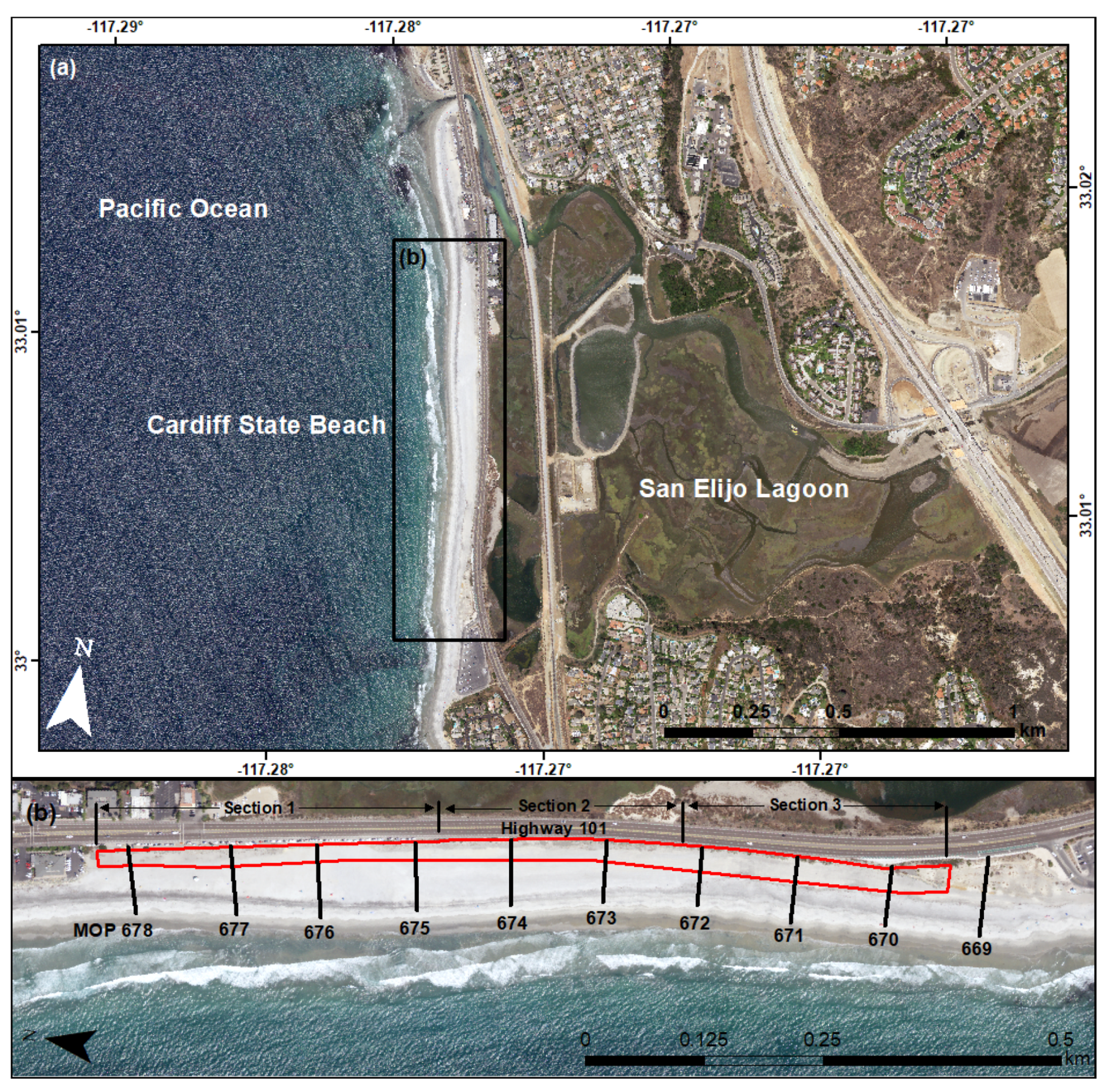
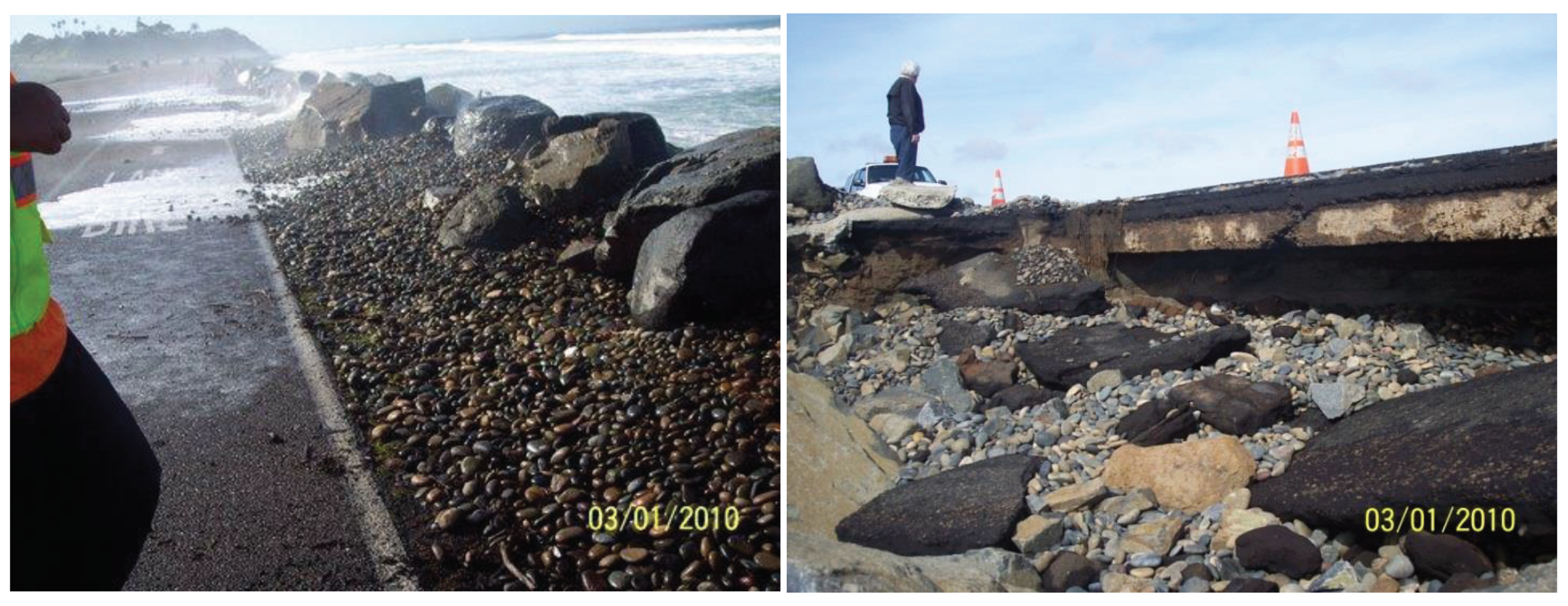
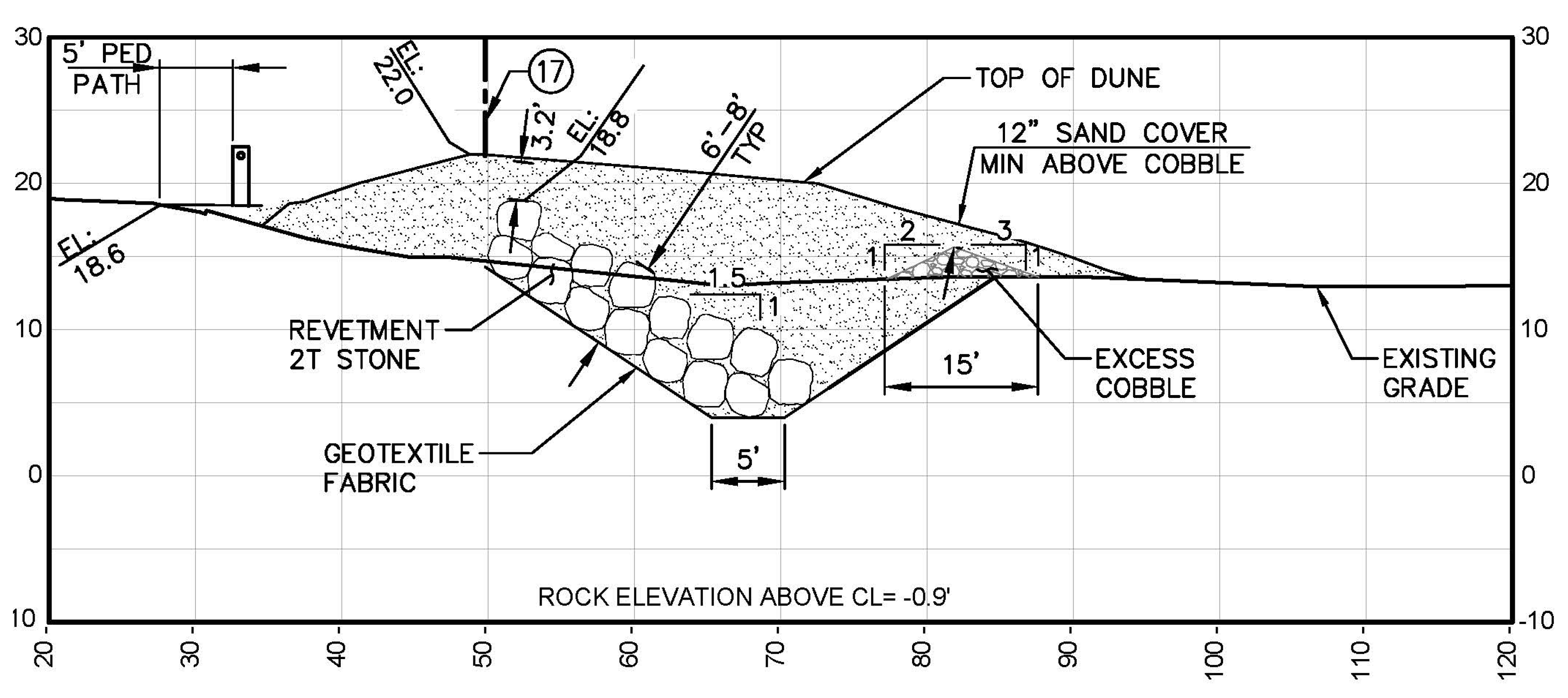
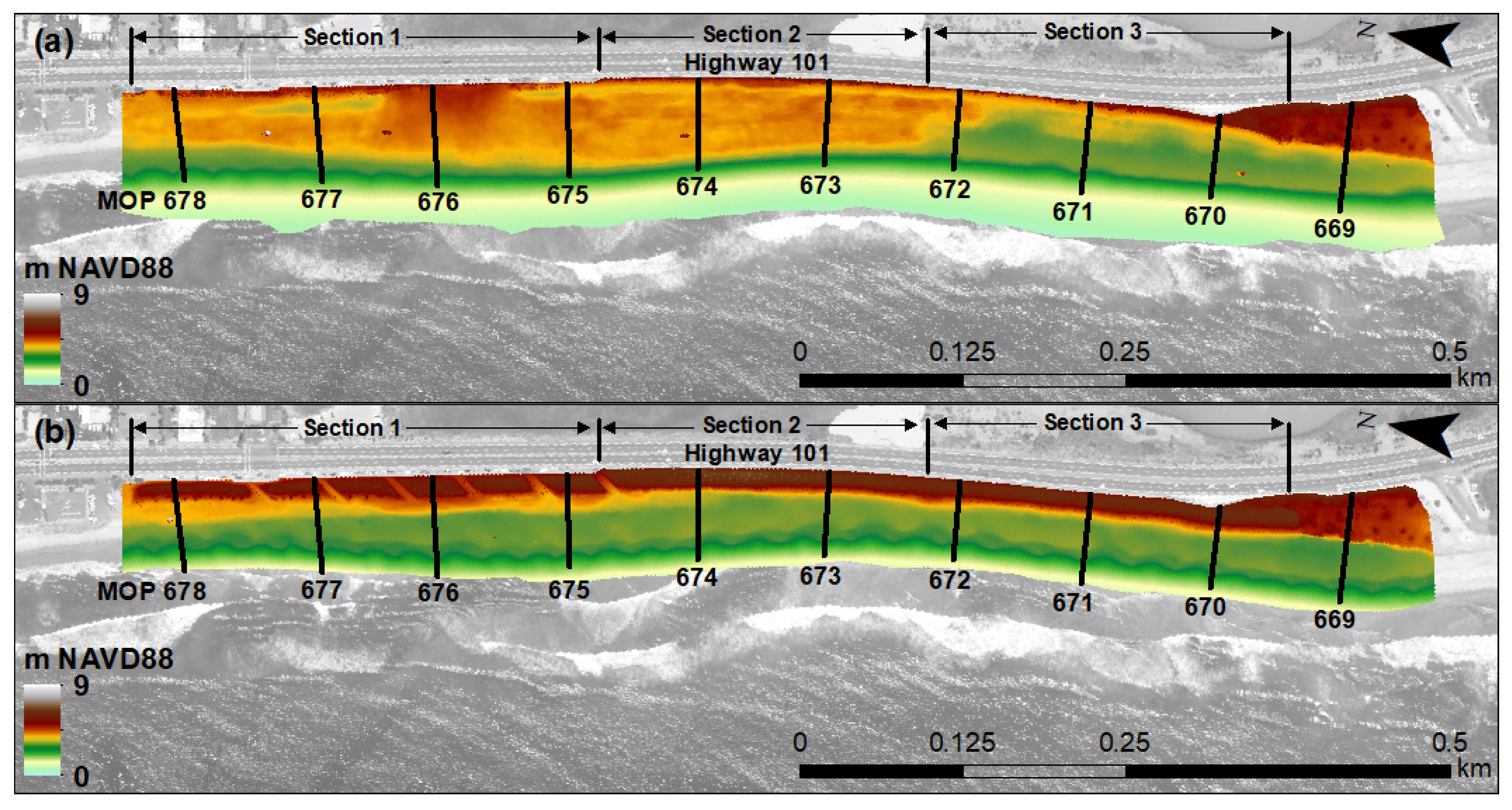



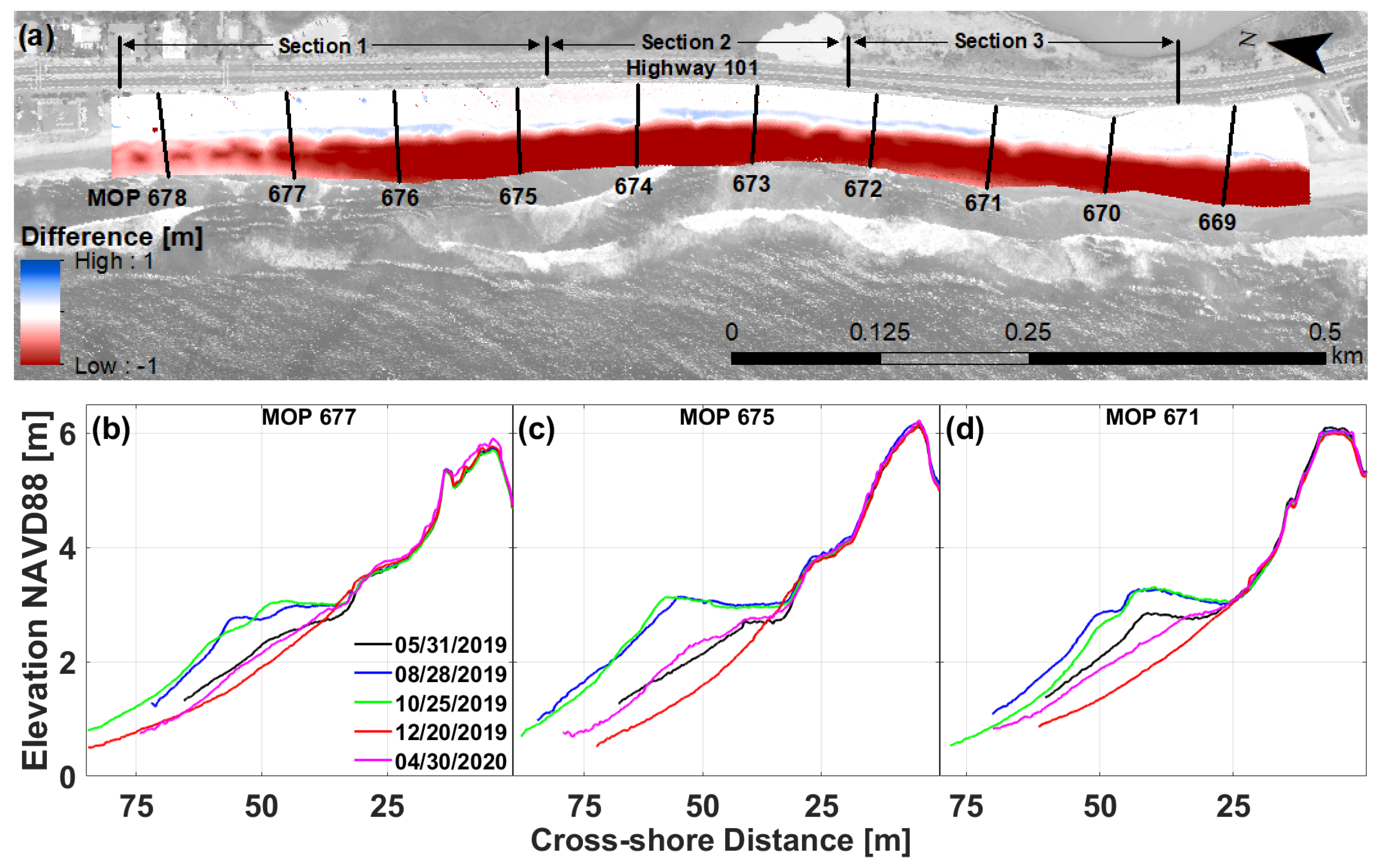

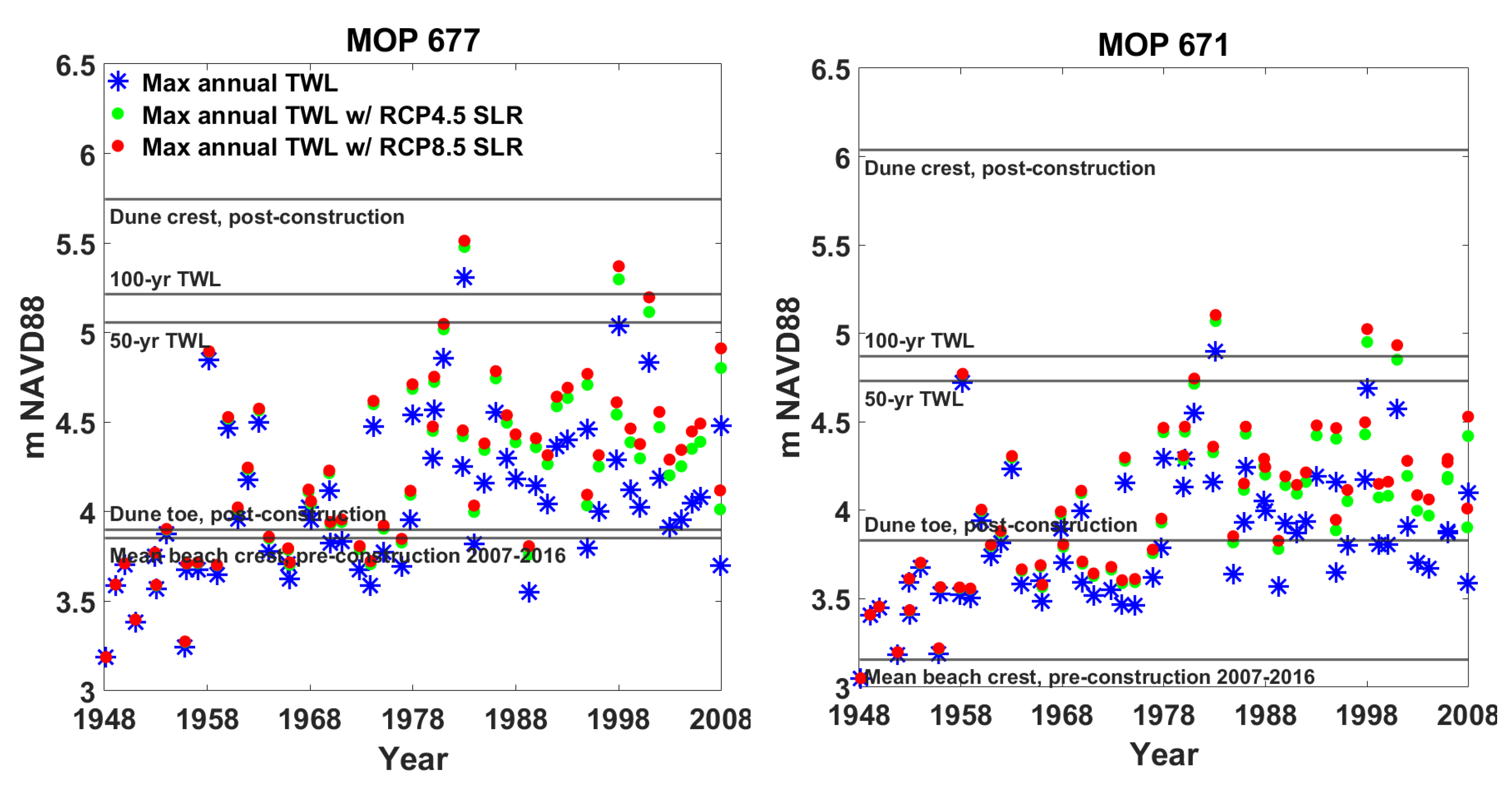
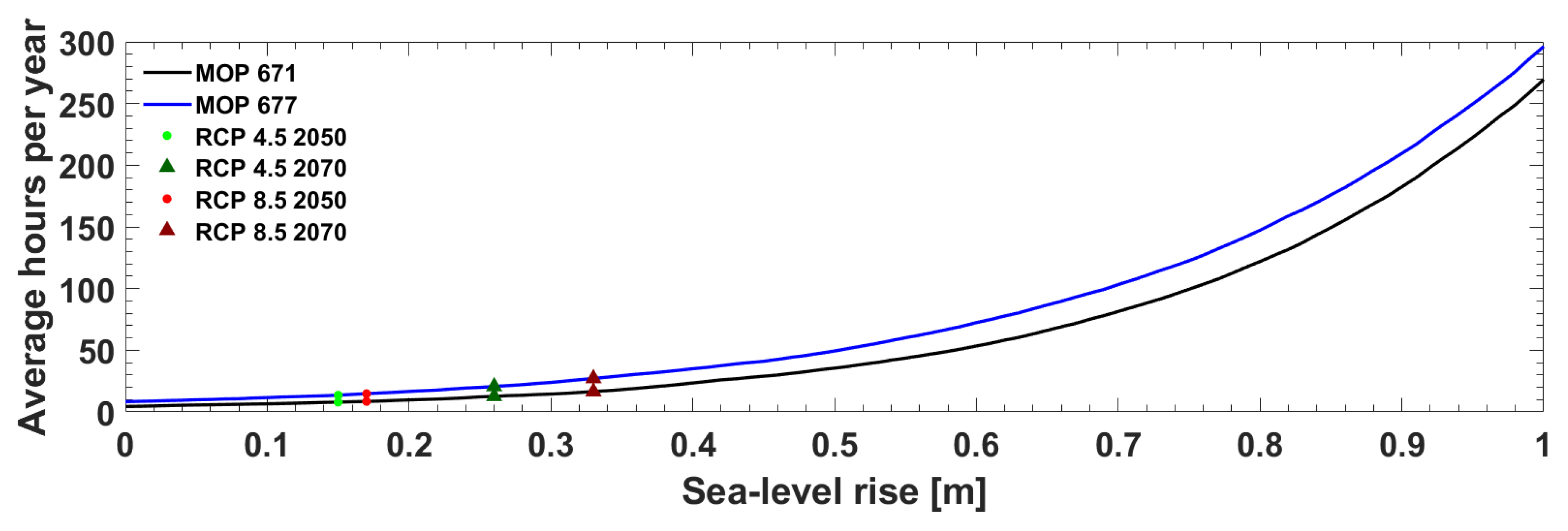
| Tide | H | T | Section 1 | Section 2 | Section 3 | ||||
|---|---|---|---|---|---|---|---|---|---|
| Date | (m) | (m) | (s) | MSL | Upper | MSL | Upper | MSL | Upper |
| 10/09/2018 | 0.39 | 1.46 | 12.5 | 87,665 | 48,601 | 60,390 | 34,984 | 53,330 | 27,269 |
| 11/28/2018 | 1.53 | 1.56 | 14.29 | 84,146 | 50,839 | - | - | - | - |
| 12/04/2018 | 0.02 | 0.44 | 12.50 | 68,396 | 41,976 | - | - | - | - |
| 12/11/2018 | 1.30 | 1.47 | 15.38 | 64,051 | 41,019 | - | - | - | - |
| 12/14/2018 | 1.08 | 1.34 | 14.29 | 66,375 | 40,723 | 40,615 | 23,216 | - | - |
| 12/17/2018 | 0.38 | 2.10 | 20.00 | 68,855 | 41,175 | 40,234 | 23,420 | - | - |
| 12/18/2018 | 0.23 | 1.87 | 16.67 | 68,062 | 41,156 | 39,391 | 22,607 | - | - |
| 12/19/2018 | −0.44 | 1.57 | 15.38 | 65,945 | 39,826 | 37,479 | 21,795 | - | - |
| 01/10/2019 | 1.33 | 2.21 | 13.33 | 61,399 | 36,113 | 37,587 | 36,113 | 39,735 | 18,907 |
| 01/22/2019 | 0.187 | 1.37 | 10.53 | 50,563 | 28,792 | 28,586 | 15,645 | 32,681 | 16,094 |
| 02/01/2019 | 0.126 | 0.9 | 15.38 | - | - | - | - | - | - |
| 03/07/2019 | 1.06 | 1.26 | 11.11 | - | - | 31,455 | 17,401 | - | - |
| 03/22/2019 | 1.358 | 1.42 | 13.33 | - | - | 34,492 | 19,604 | 38,060 | 20,446 |
| 04/05/2019 | 0.646 | 0.77 | 13.33 | - | - | 7453 | 4033 | - | - |
| 04/15/2019 | −0.089 | 0.87 | 12.5 | 56,158 | 31,962 | 38,402 | 22,592 | 41,258 | 22,935 |
| 05/31/2019 | 0.385 | 1.36 | 14.29 | 63,932 | 34,103 | 45,477 | 25,669 | 50,803 | 28,400 |
| 08/28/2019 | 0.646 | 1.07 | 20.00 | 73,871 | 40,288 | 53,696 | 30,157 | 57,251 | 32,154 |
| 10/25/2019 | 0.173 | 0.72 | 9.09 | 73,375 | 39,967 | 52,130 | 30,087 | 54,743 | 32,046 |
| 12/12/2019 | 0.304 | 1.07 | 12.5 | - | 35,598 | - | 26,191 | - | 26,636 |
| 12/20/2019 | 0.365 | 0.93 | 11.76 | 61,451 | 34,223 | 40,831 | 24,320 | 44,845 | 26,254 |
| 04/30/2020 | 0.047 | 0.96 | 10.53 | 63,017 | 34,580 | 45,224 | 25,224 | 51,008 | 28,764 |
Publisher’s Note: MDPI stays neutral with regard to jurisdictional claims in published maps and institutional affiliations. |
© 2020 by the authors. Licensee MDPI, Basel, Switzerland. This article is an open access article distributed under the terms and conditions of the Creative Commons Attribution (CC BY) license (http://creativecommons.org/licenses/by/4.0/).
Share and Cite
Winters, M.A.; Leslie, B.; Sloane, E.B.; Gallien, T.W. Observations and Preliminary Vulnerability Assessment of a Hybrid Dune-Based Living Shoreline. J. Mar. Sci. Eng. 2020, 8, 920. https://doi.org/10.3390/jmse8110920
Winters MA, Leslie B, Sloane EB, Gallien TW. Observations and Preliminary Vulnerability Assessment of a Hybrid Dune-Based Living Shoreline. Journal of Marine Science and Engineering. 2020; 8(11):920. https://doi.org/10.3390/jmse8110920
Chicago/Turabian StyleWinters, Maria A., Brian Leslie, Evyan Borgnis Sloane, and Timu W. Gallien. 2020. "Observations and Preliminary Vulnerability Assessment of a Hybrid Dune-Based Living Shoreline" Journal of Marine Science and Engineering 8, no. 11: 920. https://doi.org/10.3390/jmse8110920
APA StyleWinters, M. A., Leslie, B., Sloane, E. B., & Gallien, T. W. (2020). Observations and Preliminary Vulnerability Assessment of a Hybrid Dune-Based Living Shoreline. Journal of Marine Science and Engineering, 8(11), 920. https://doi.org/10.3390/jmse8110920





